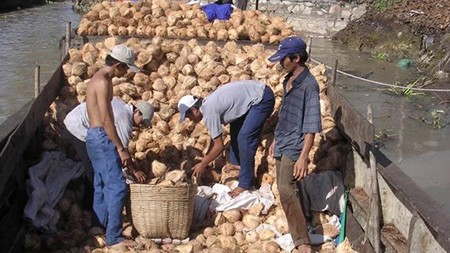
The lowest price ever
Everywhere in the Mekong Delta province of Ben Tre – the largest area of coconut planting – farmers are groaning about the low price of the produce.
According to Mr. Nguyen Van The, living in Giao Long Commune of Chau Thanh District (Ben Tre Province), this time last year, the consumption volume was so high that he did not have enough coconuts to sell. The price at that time was VND100,000 – 150,000 per dozen (approx. $4.4 – 6.6).
Yet this year the prices of premium-quality and medium-quality coconut are only VND45,000 – 50,000 ($1.97 – 2.2) and VND20,000 – 30,000 ($0.9 – 1.3) per dozen, respectively. After careful calculation, due to such a low price, this year his profit is purely negative, although he owns 2.5 acres of land.
Mr. Le Hoang Phi, also living in Giao Long Commune, worriedly shared that coconut trees are the main income source of many households in his area. Yet this year, even with such a low price, the purchasing power is still not as high as expected.
In other areas of Ben Tre Province like Binh Dai District, Mo Cay Nam District, the situation is not any brighter. According to the Division of Agriculture and Rural Development of Mo Cay Nam District, the surface area of coconut trees is over 14,700ha, providing around 74 million coconuts annually. With a low selling price of this produce, many households are gravely affected.
In the neighboring province of Tra Vinh, coconut farmers are also desperate.
As explained by the Ben Tre Department of Industry and Trade, this negative situation is caused by many factors. One of them is that Muslim nations do not place many orders since the fasting season has come. What is more, the Southeast Asia has entered the coconut harvesting time, and the volume of coconut all over the area greatly increases. The last reason is the decrease of orders of material coconuts from China.
The cooperative solution
The latest statistics show that in the whole Mekong Delta, the surface area of coconut planting is around 130,000ha, accounting for 78 percent of the whole nation. This produce is the main income source of more than 1.9 million households.
However, the weakness of this farming industry lies in the fact that farmers do not cooperate with one another while the infrastructure to serve coconut plantations is seriously limited. This has made farmers wavering between continuing with coconut growing or changing to other more profitable crops.
To address this problem, there must be a closer collaboration among coconut farmers as well as between farmers and businesses to guarantee outputs. In addition, the model of crop rotation should be considered to improve possible profits.
According to Mr. Nguyen Van Hoanh, a farmer in Giong Trom Town of Giong Trom District in Ben Tre Province, his 2-hectare farm follows the crop rotation between coconut and pomelo. After nearly 4 years, both crops begin to show great potential. The productivity of both fruits increases more and more, and he earned nearly a few hundreds of millions of VND last year (more than $10,000).
This solution is feasible and promising to be applied widely since it can raise profit within the same surface area.
As shared by Mr. Nguyen Van Tron, Head of the Cooperative Group for Coconut Care in Hung Le Commune of Giong Trom District, after unsuccessful spontaneous working, since 2013, farmers in his commune has followed instruction of the related authorities to form a group of 60 members to plant coconuts on a surface area of 63ha.
They received training as well as seed provision from professionals. They were also supported with fertilizers and guaranteed outputs, which made them much more confident. One noticeable point is that they were carefully instructed to grow coconut in accordance with Japanese and European standards to increase the quality and value of their produce.
According to the Ben Tre Department of Agriculture and Rural Development, the most urgent solution at this moment is to re-organize coconut planting and encourage farmers to join in cooperative groups. From that point, they will all be trained properly on techniques, growing and harvesting time, as well as introduced to suitable businesses to ensure their output.
Simultaneously, the local authorities should introduce policies to logically divide the coconut growing area into industrial coconut and coconut for juice ones, along with applying the model of crop rotation.
























